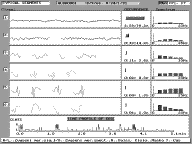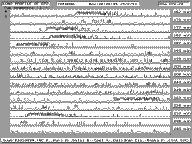Long-Term Electro-encephalogram Analysis
by Vladimír Krajca
The EEG laboratory of the Department of Neurology, Faculty Hospital Bulovka in Prague has long-standing research activities in the field of computer-based electroencephalo-gram (EEG) signal processing.
Two research projects have recently been activated by the Internal Grant Agency of the Ministry of Health of the Czech Republic with the objective to analyse long term EEG recordings.
The first, application of the modern methods of the digital signal processing in epileptology and in the sleep analysis, resulted in the development of a methodology for structural description of the long term EEG recordings. The system of automatic signal processing, called Wave- Finder, works in several steps.
At first, multichannel adaptive segmentation is used to divide the signal into piece-wise stationary segments and to extract the relevant features from them. An improvement of the classical method of Bodenstein & Praetorius, which creates extension to several EEG channels, is used. Cluster analysis (k-means algorithm) groups the segments into homogeneous classes. A typical, representative segment is plotted for each class, providing the summary and quantitative information of the signal (percentile occurrence of the segments, etc).
Typical, representative segments of each class and time profile plotted for a patient with diagnosis epilepsy can be seen on figure 1.
Structural information is revealed in the time profiles (plotting of the class membership in the course of time). The example on figure 2 presents a part (167min-243min) of time profile of a sleep recording with total recording time 8 hours. Different sleep events are clearly discernible.
 |
 |
| Figure 1: Single-channel summary sheet with
representative segments of each class and time profile for a patient with
epilepsy diagnosis. |
Figure 2: Structural analysis of sleep EEG record by one-channel time profile. |
The main objective of the second project, Numerical quantification of digitised EEG recordings for the long-term monitoring of brain activity, is the research, development and implemen-tation in clinical practice of the mathematical methods and algorithms for estimation of the set of numerical parameters for objective description, comparison, and monitoring of the development of EEG recordings on a personal computer. The pool of computer algorithms based on a contemporary digital signal processing theory, pattern recognition and artificial intelligence will provide a numerical characterization of the EEG development. The clinical task is to assess the usefulness of mathematical tools for the diagnosis improvement in several selected application areas, especially in the field of cerebral function monitoring in new-born and prematurely born infants (in cooperation with the Institute of Mother and Child Care, Prague), in epileptology (Bulovka Hospital, Department of Neurology) and during coma (University of Göteborg, Department of Clinical Neuroscience, Sahlgren Hospital ). The best performing algorithms will be selected for implementation in clinical practice.
Finally, our last project deals with the development of efficient adaptive signal parameter estimation techniques, joint project with the Technical University Ilmenau, Germany. This research project is based on our common experience in the areas of applied mathematics, neurology, neonatalogy and neuro-physiology. The objective of the project is to develop and test optimal EEG analysis methods and join them together into integrated system for EEG monitoring and interpretation.
Please contact:
Vladimír Krajca - Faculty Hospital Bulovka
Tel: +420 2 66082307
E-mail: krajca@neuro.anet.cz
